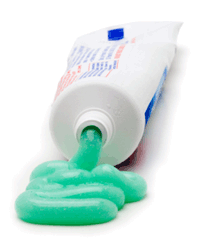Is Product Splintering The Future Of Software?
Filed Under Software Process, Thought Stuff

Recently, I read an interesting thought about how the future of all software is bloatware. While I do agree with this, I feel the extreme holds true as well that in the future (or even now) we will be saturated with smaller niche products otherwise known as – Product Splintering.
Product Splintering is a marketing term to describe when a company purposefully splits or “splinters” a product into multiple products. You need not look any farther than your toothpaste isle to see an example of this in action. A Mega-Does-Everything Toothpaste does not exist; instead we have whiteners, fresheners, kid friendly, and clean mint. They have essentially made one core product and spun 10-20 unique niche products from it.
Why would a company do this instead of creating one really great product? There are a number of reasons…
Niche “Me” Fullfillment
First and foremost with product splintering is the marketers ability to prey on the consumers want to feel “special”. This is exactly why modern coffee shops tolerate people ordering triple-shot-grande-non-fat-dry-cappuccino (yep, that’s my order).
When you go niche, people feel they are getting a specialized just-for-them product. The connection between the consumers current problem and a prominent solution increases the ability for a sale.
For example, although Toothpaste X may whiten teeth better than Super Whitening Toothpaste Y, Toothpaste Y has the higher ability to sell to consumers looking for that specific attribute. The consumer will implicitly connect more with the product willing to solve their current problem (i.e. yellow teeth). Rinse and repeat with numerous dental problems, and you have an army of products willing to solve any specific problem.
Software in the future may also become smaller and more specialized solving only the one or two biggest problems.
Market Saturation
Is it better to have one product on the shelf or ten? You guessed it, having more products on the shelf all branded in the same fashion takes up more physical real estate on the shelf. In turn, it takes up more of your attention and raises the probability for you to buy their product.
This actually happens on the internet all the time. Think about it – is it better to own one video game store or twenty video game stores? Bigger footprint in the search engines, bigger footprint in PPC, and a higher probability for resales even if the consumer changes stores.
The New Factor
People love “new” stuff, and this is why small business will always have a chance. Is toothpaste new? Nope. Cars, nope. Underwear, nope. Yet there are plenty of “new” products coming out in those niches, some of which on nothing more than rebranded original products.
When we splinter products and apply different names to them, it gives us a better opportunity to remarket the old as “new”
So where does all this hip, new marketing information take us? Well, it does point exactly to the model that some Micro ISV’s are taking to publish their software solutions. 37 Signals probably being at the forefront of this niche, single solution products – but there are many many others. How about all those XHTML splicing services such as PSD Gator? One problem, one service option.
Is bloatware still a problem in future software? Of course, without question. Is product splintering an equal player in this ever growing web world. Yes…yep…you know it…you betcha…it’s a go…you get the point…. 😉
4 Responses to “Is Product Splintering The Future Of Software?”



[…] Is Product Splintering the Future of Software (Max Pool) […]
Very thought provoking post!
From what I heard (didn’t exist at that time), software splintering has been a major philosophy in the development of tools for Unix since it’s beginnings… Today many of the tools available for Linux continue with this idea, tools for doing one specific task in the best possible way. I think users are slowly starting to see that more features isn’t always better, when your system is crawling you wish you could get rid of them all. The first example that comes to my mind is MSFT Office, with all those menus and submenus, you get dizzy. Sorry for my english, greeting from Argentina!
[…] Product Splintering – http://www.codesqueeze.com/is-product-splintering-the-future-of-software/ […]